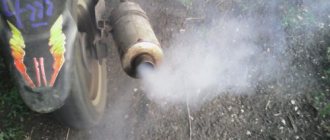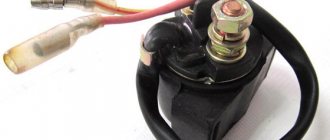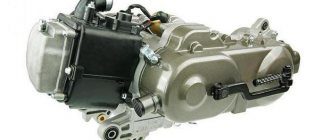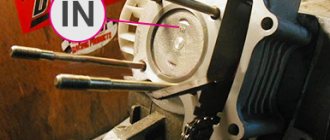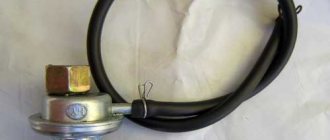GENERAL CHARACTERISTICS OF THE PROBLEM
If your motorcycle is in good working order, then the exhaust is nothing more than a combination of water and carbon dioxide. Without impurities and additional components. However, in the case of fuel combustion, we are not dealing with pure oxygen, but with diluted nitrogen.
The color of smoke from a motorcycle muffler can be different: white, black and even blue. By its shade we are able to determine the nature of the breakdown. Often, smoke appears with other signs of malfunctions that are not noticed at first. This is the first sign that a serious breakdown is soon possible. And it needs to be excluded.
The problem is that even the most modern motorcycles experience incomplete combustion and oxidation of fuel. Accordingly, more CO and CH come out. Because of this, when changing fuel, a change in the color and consistency of exhaust smoke may be observed. In addition, sometimes oil or coolant used gets into the combustion chamber, which gives off its chemical compounds and is thrown out.
Another common cause is the wear and tear of the filter system. No matter how carefully you treat your motorcycle, filters perform their functions worse and worse over time. Therefore, if changes in the color of the exhaust are observed, perhaps replacing the filters will be the simplest solution to the problem. However, the matter may be completely different. Let's consider different options and possibilities for solving the problem.
In most cases, white smoke is a common occurrence in winter when you warm up your motorcycle in the morning. And almost always it is not smoke, but ordinary steam. Due to the temperature difference in the exhaust pipe, condensation always forms when it cools, after which it freezes until the next time the motorcycle warms up. When you start the car, the exhaust pipe also begins to heat up, melting the frozen condensate and turning it into a gaseous state. In this case, water may also drip from the pipe, which is also not a serious problem in this case. And the colder it is outside, the more noticeable the smoke is. Yes, and humidity plays a role. The higher it is, the thicker the white steam.
But what to do when the exhaust of an unusual color from the muffler is observed non-stop even in warm summer weather? This phenomenon is primarily associated with the penetration of liquid into the cylinders. As a rule, these are coolers: antifreeze, antifreeze or even plain water. In this case, there is a chance that you need to replace the cylinder head gasket. The moisture does not evaporate completely and smoke with a high density is formed. Characteristic is the fact that the color and density of the exhaust can vary greatly depending solely on the type of coolant. Low quality and cheap in itself can cause a lot of trouble.
In order to better understand the nature of white smoke, you need to carry out diagnostics. It mainly occurs due to problems in the cooling system. If there is a hint of its malfunction, we strongly recommend that you carry out a series of checks. First of all, you should make sure that the liquid is evaporating from the muffler. Warm up the engine to its usual operating temperature (the procedure can be carried out even after some travel). Find a clean piece of paper and apply it to the pipe, partially blocking the hole with it.
We draw conclusions: if it is water, it will turn into steam, without leaving behind any greasy, oily traces; if there are greasy stains on the sheet, there is clearly a problem in the system.
If the sheet is clean, we continue the search. The problem of moisture ingress may lie not in the gasket itself, which due to certain factors was damaged, but also in cracks in the cylinder blocks. They can usually be detected without problems upon careful examination.
There is another fairly common reason for the appearance of white smoke - the engine does not have time to warm up. If you drive a little and over short distances, condensation accumulates more and more and does not have time to escape. As a result, the exhaust may become so clogged with condensate that the car simply will not start. To avoid this, we recommend that you fully warm up the motorcycle at least once a day, and if possible, use auto-warming.
But detected problems, which are accompanied by white smoke from the muffler, do not just require urgent elimination of their causes. They require careful inspection and elimination of defects in the cooling system, since, as practice shows, they are caused by engine overheating. There is a possibility that the thermostat is faulty or the switch is not working, the radiator is not sealed, etc.
To summarize, we can say that in winter you should not particularly focus on the appearance of white smoke. The problem solves itself with the arrival of heat without your participation.
Oil getting into the cylinders is the most common reason for its regular appearance. The smoke itself can have a whole range of different tones: from unclouded bluish to a rich bluish tint. The blue smoke does not immediately dissipate in the air, and when performing a test with a piece of paper, dirty, oily droplets are left on it, which come out along with the exhaust gases. There are several key reasons for the blueness of smoke:
- Damage to valve stems, guide bushings and wear of valve stem seals. They noticeably increase the amount of smoke while the engine warms up.
- Excessive oil consumption is observed in engines that have a turbocharger. Cause: A faulty turbocharger, which you will most likely need to replace.
- Malfunctions of the ventilation system. Its task is to separate the oil and adjust the flow rate. It needs to be reconfigured or replaced.
- When blue smoke appears from the muffler, you must closely monitor the oil level so that it is normal, and be sure to monitor the serviceability and suitability of the piston group parts.
If you notice that oil is being consumed faster than usual, this is a clear sign of a ventilation problem. The cost of replacement is low, so there is little point in repairing it. It's easier to buy.
Izh Planet 5 troubleshooting
Izh Planet 5 malfunctions and ways to eliminate them:
1. Cause of malfunction 2. Remedy
Kickstart lever skips or does not return (slowly returns) to its original position
1. Rotating the kickstarter lever on the shaft. 2. Tighten the lever mounting bolt; if the splines are severely damaged, replace the lever or shaft.
1. In cold weather, too viscous oil is poured into the gearbox. 2. Replace the oil corresponding to the ambient temperature (viscosity according to SAE 5W30; 10W30) or, as a temporary measure, you can slightly dilute the oil in the gearbox by pouring 100-150 cc into it. cm gasoline or kerosene. Remember to replace this mixture with “normal” oil as soon as possible.
1. Chips or severe wear of the sector teeth, ratchet or trigger gears. 2. Replace damaged parts, be sure to flush the gearbox.
1. The gear sticks on the clutch drum hub. 2. Eliminate jamming, dull the sharp edges of the gear hole.
1. The trigger spring has burst or weakened. 2. Replace the spring.
1. The retaining ring has come off the clutch drum hub. 2. Replace the ring or drum.
Engine won't start
1. The ignition is turned off by the emergency switch. There is no spark at the spark plug. 2. Turn on the ignition.
1. There is no fuel in the tank. 2. Fill the tank.
1. On a cold engine, the starting device (fuel corrector) is not turned on. 2. Turn the fuel corrector lever and, if necessary, eliminate the drive malfunction (sticking cable or corrector plunger). After starting and warming up the engine, return the corrector lever to its original position.
1. Fuel does not enter the carburetor due to clogged filters or valve channels (there is no stream of fuel from the hose removed from the carburetor and the fuel valve is open). 2. Remove the valve, disassemble and wash all parts in solvent, blow out the channels and the fuel hose with compressed air. After installing the valve and connecting the hose to the carburetor, press the float reducer to fill the carburetor float chamber with fuel.
1. There is no spark on the spark plug due to it being oiled with the fuel mixture, poor contact between the tip of the spark plug and the high-voltage wire, or another malfunction of the spark plug. Fuel condensate has accumulated in the crank chamber of the engine, which leads to over-enrichment of the combustible mixture and the impossibility of its ignition. 2. Turning off the fuel supply and opening the decompressor valve, blow out the crank chamber and cylinder with several slow movements of the kick starter lever. If this does not help, remove, clean or replace the spark plug. Ensure reliable contact in the connection of the high-voltage wire with the tip of the spark plug.
1. Other elements of the ignition system are faulty or the connections between them are in poor contact (no spark on the spark plug). 2. Check one by one the high-voltage wire, ignition coil, capacitor, operation of the breaker contacts, ignition timing, fuse and battery charge, ignition switch. Replace faulty elements, ensure reliable electrical contact between them. If necessary, adjust the ignition timing, check the level and density of the electrolyte, clean the surface, terminals and terminals of the battery, charge or replace the battery.
1. The throttle valve (its drive) or the carburetor needle valve is stuck, the fuel jets and carburetor channels are clogged, in particular the starting device channels. 2. Wash the carburetor parts in a solvent and blow out the channels with compressed air, repair and adjust the carburetor, as well as the throttle valve drive.
The engine does not start immediately, is unstable, does not respond well to turning the throttle, and stalls spontaneously
1. The carburetor needle valve is dirty or damaged; the position of the float in the float chamber is not adjusted. 2. Clean and repair the valve, adjust the position of the float.
1. Over-leaning of the combustible mixture due to the float or valve needle sticking in the upper position, float leakage, clogging of the carburetor jets and channels. 2. Wash, repair and adjust the carburetor.
3. Over-leaning of the combustible mixture due to the suction of additional air into the crank chamber through various leaks. For example: the gasket between the cylinder and the crankcase, the gasket of the suction pipe or leaks in its connection, the gasket of the right crankshaft oil seal cover, the gaskets of the purge channel plugs. “Extra” air can also get into the combustible mixture through worn right or left crankshaft oil seals, as well as a loose joint between the crankcase halves. In the last two cases, oil quickly “leaves” from the gearbox, and with worn seals, the engine smokes more than usual, although visible oil leaks may not be noticeable. 2. Tighten the fastenings of all specified parts, if necessary, replace damaged gaskets, hardened and worn oil seals. Eliminate leaks in the suction pipe connection. If necessary, disassemble and reassemble the engine, reliably sealing the joint between the crankcase halves.
1. Contamination, burning, moisture on the breaker contacts, incorrect adjustment of the gap between the breaker contacts, the ignition is installed incorrectly, the hammer spring touches the engine ground.
2. Clean the contacts, set the correct gap and ignition timing, eliminate contact of the spring with ground.
1. Capacitor malfunction (manifests itself in the form of strong sparking between the breaker contacts). 2. Replace the capacitor, check the condition of the contacts, and clean them if necessary.
1. Malfunction of the ignition coil. 2. Replace the ignition coil.
1. Severe carbon deposits, wear, burning of electrodes (increased gap) or other malfunction of the spark plug, contamination of the high voltage wire cap and the outer surface of the spark plug insulator, use of a spark plug with an inappropriate heat rating. 2. Clean or replace the spark plug. Keep the wire connection to the spark plug clean, use only recommended spark plugs.
1. There is too much oil in the fuel mixture. Thick bluish smoke comes out of the mufflers. It is possible that the gasoline evaporated when the mixture was stored for a long time in a plastic canister or some other leaky container. 2. Replace the fuel mixture, turn it out and rinse in clean gasoline or solvent (or replace) the spark plug.
When starting the engine, the kickstarter lever “gives” to the leg
1. Early ignition. 2. Adjust the ignition timing.
The engine starts and runs fine, but after a while it stalls.
1. The drain hole in the fuel tank plug is clogged (due to the vacuum created in the tank, fuel does not flow into the carburetor). 2. Clean the hole in the plug.
1. The carburetor metering needle has “fallen”. 2. Place the needle in its original place, securing it securely, and adjust the carburetor if necessary.
1. The drain hole in the float chamber cover is clogged. 2. Clean the hole.
1. The oil is poorly mixed with gasoline, water has entered the mixture, or gasoline has partially evaporated during long-term storage of the fuel mixture (in a plastic canister or unsealed container). 2. Fill the tank with fresh fuel mixture with the recommended ratio of components
The engine operates unsteadily under load (while driving) and does not develop power
1. Carburetor channels and jets are clogged. 2. Wash the carburetor parts with solvent, blow out the channels and jets with compressed air.
1. The carburetor forms an excessively rich mixture (shots in the muffler, thick exhaust smoke, overheating, blue exhaust pipes) or, on the contrary, a lean mixture (popping in the carburetor, “sneezing” of the engine) due to high or low fuel level in the float chamber or incorrect (too high or low) position of the dosing needle. 2. Adjust the carburetor.
1. The fuel corrector drive is stuck or faulty, the corrector needle or plunger has “fallen”. 2. Eliminate the drive malfunction, set the corrector needle to its normal position.
1. The fuel nozzle or nozzle has become twisted due to vibration. 2. Screw the parts into place.
1. The throttle valve does not open due to jamming of the drive. 2. Repair the drive, adjust the throttle position.
1. High resistance to air flow at the inlet; the filter element of the air cleaner is clogged with dust or foreign objects (rags, debris) have entered the intake pipe. 2. Disassemble, wash the air cleaner, pour oil into it.
1. Increased resistance to exhaust gases due to the formation of heavy carbon deposits in the exhaust system; the baffle in the muffler may have become detached from the body. 2. Clean the exhaust system parts, including the cylinder exhaust ports, from carbon deposits. Shake the cleaned muffler vigorously; if you can hear parts moving freely inside it, replace the muffler.
1. The ignition is installed incorrectly. When igniting early, the engine knocks. If it is “late”, there may be shots in the muffler, thick exhaust smoke, overheating (blue discoloration) of the exhaust pipes. 2. Adjust the ignition timing.
1. Seized or broken piston rings, low compression in the cylinder. 2. Having removed the piston with rings, wash it in a solvent or a special cleaning composition, ensuring complete removal of carbon deposits and free movement of the rings in the grooves. In case of severe wear, breakage of rings, scuffing and enveloping of metal, replace (by selecting as a set) the cylinder, piston and piston rings. Check for carbon deposits in the exhaust system and, if necessary, remove carbon deposits (see above).
To prevent malfunctions, use only high-quality fuel and oil in the correct proportions, and do not allow the oil level in the air filter cavity to exceed.
1. General severe wear of parts of the cylinder-piston group (CPG), low compression in the cylinder. 2. Replace, selecting a complete set of cylinder, piston and piston rings.
1. Gas breakthrough at the junction between the cylinder head and the cylinder. 2. Evenly tighten the cylinder head nuts. If necessary, remove and lap the head to the cylinder to ensure a tight joint.
1. Gas breakthrough through a slightly open decompressor valve. 2. Repair the decompressor valve or its drive.
The throttle valve does not return to its original position (the “gas” is not released), the “gas” handle rotates with noticeable resistance
1. Contamination, breakage of individual wires or breakage of the throttle control cable sheath. 2. Remove, wash and lubricate the throttle control cable; if damaged, replace the cable.
1. Sticking of the throttle valve due to contamination, damage or weakening of the spring. 2. Flush the carburetor, ensure free movement of the throttle valve, and replace the spring if necessary.
The engine overheats, does not develop power, when adding gas, noticeable detonation is possible, sometimes due to the increased exhaust temperature the exhaust pipes turn blue
1. Driving for a long time in hot weather in low (first and second) gears. 2. Stop, wait for the engine to cool, and maintain a driving mode favorable for sufficient cooling.
1. Prolonged operation of the engine on a lean mixture (popping noises in the carburetor, “sneezing” of the engine). 2. See “The engine does not start immediately. "
1. The ignition is installed incorrectly. When igniting early, the engine knocks. If it is late, there may be shots in the muffler, thick exhaust smoke, and overheating (blue discoloration) of the exhaust pipes. 2. Adjust the ignition timing.
1. Rich mixture, the symptoms are the same as with late ignition (see point 3). 2. Repair and adjust the carburetor.
1. There is not enough oil in the fuel mixture (increased mechanical noise). 2. Use a fuel mixture with the recommended oil content in gasoline.
1. A decrease in the octane number of gasoline, for example, as a result of long-term (more than three years) storage of the fuel mixture in a tank or canister. 2. Replace the fuel mixture, and before starting the engine, blow it out by opening the decompressor valve.
1. Severe contamination of the surfaces of the power unit, primarily the cooling fins of the cylinder and head. 2. Do not operate a motorcycle with a contaminated power unit, especially in the hot season.
1. Carbon fouling of the combustion chamber, exhaust channels and piston crown. As a rule, carbon deposits are intensively deposited in the exhaust system. 2. Having removed the exhaust system, cylinder head and cylinder, clean the parts from carbon deposits and eliminate the causes of its appearance (see above).
Increased fuel consumption
1. Strong headwind, off-road conditions, transporting passengers and cargo. 2. The reasons are irremovable!
1. Long-term driving in low gears at high speed, “sporty” driving style. 2. Shift into higher gears in a timely manner and drive the motorcycle in a relaxed manner.
1. The air purifier is dirty. 2. Rinse the air purifier and fill it with oil
1. Carburetor adjustment is incorrect (rich mixture). 2. Adjust the carburetor.
1. Leaking fuel system. 2. Eliminate the causes of fuel leakage.
1. Increased mechanical rolling resistance of the motorcycle. Reasons: low tire pressure, the final drive chain is overtightened, brake pads rub against the drums (the drums heat up when driving, the motorcycle is difficult to roll “by hand”). 2. Eliminate the causes of increased rolling resistance of the motorcycle.
Knocking, loud noise, humming, vibration or rattling sounds when the engine is running in all modes. The engine does not develop power
1. Large gap between the piston and cylinder due to severe wear or incorrect selection of parts during repairs. 2. Choose the right parts or. replace the complete CPG.
1. Premature self-ignition of the fuel mixture (“glow ignition”) due to the installation of a spark plug with an inappropriate thermal characteristic. 2. Install the “correct” spark plug.
1. Large ignition timing. 2. Adjust the ignition timing.
Loud knocking, clicking, loud noise, humming, strong vibration or rattling sounds when the engine is running in all modes. When driving, a sharp drop in power may occur until the CPG jams (complete engine stop)
1. Breakage of the piston rings, melting or fracture of the bridges between the rings, burnout of the piston bottom. “Sticking” of the piston in the cylinder. The ends of the rings getting into the cylinder windows due to the ring locking pin falling out, scuffing of the cylinder mirror by the piston, burst rings or the end of the piston pin as a result of the locking ring falling out and axial displacement of the pin in the piston. Severe wear or destruction of the connecting rod and crankshaft bearings, deformation of the connecting rod, jamming and turning of the crankshaft main bearings in their seats. The result is a displacement of the crankshaft and contact of the generator rotor with the stator. 2. Stop immediately and turn off the engine. After disassembling the engine, establish the cause of rapid wear or damage to parts (overheating, detonation, ingress of dust or other foreign particles through a faulty air filter, lack or low quality of oil in the fuel mixture, overload of the power unit, poor-quality assembly or defects in the manufacture of parts, violation of break-in rules new or refurbished engine). Repair the engine by replacing damaged parts. Eliminate the cause of the malfunction.
Passage of gases, strong unusual noise when the engine is running
1. Gas breakthrough at the junction between the cylinder and the head or through a slightly open decompressor valve. In both cases, smoke is noticeable around the cylinder head. 2. Tighten the head fastening nuts evenly. If necessary, remove and lap the head to the cylinder. Repair the decompressor valve or its actuator.
1. Gas breakthrough through leaks in the exhaust system. 2. Tighten the exhaust system ring nuts. If gas breakthrough does not stop, replace the “lower” or “upper” seals. If the muffler burns out, replace it.
Oil leak from air filter housing
Cyclic knocking noise at idle that disappears when the clutch lever is pressed
1. The tension of the motor transmission chain has weakened as a result of its wear (the sagging of the chain branch is more than 14 mm) or simultaneous wear of the sprockets. 2. Replace the chain. If the sprockets are severely worn (if the branch of the new chain sags by more than 7 mm), replace the motor transmission sprockets. Use high-quality gearbox oil, do not allow it to leak, and do not overload the power unit.
1. The crankshaft sprocket bolt is loose. 2. Tighten and securely lock the bolt.
The clutch does not disengage at all or “drives” (does not disengage completely)
1. Broken clutch cable. 2. Replace the cable.
1. Warping of the driven discs (due to their overheating), uneven spring force 2. Disassemble the clutch, checking the condition of the discs. If necessary (cracks, severe wear, burns), replace the discs and adjust their preload by turning the spring adjusting nuts.
1. Clutch release drive adjustment is broken 2. Adjust the drive
The clutch does not fully engage (slips), to the point that the motorcycle cannot move when the clutch lever is released
1. The free play of the clutch lever is not adjusted. 2. Adjust the free play of the lever.
1. The clutch spring preload is not adjusted (the springs are weakened). 2. Adjust the spring preload by turning the adjusting nuts (replace the springs if necessary).
1. Severe wear or warping of the clutch discs, damage to the disc protrusions. 2. Replace disks, adjust drive.
The clutch disengages with difficulty
1. Jamming of the clutch cable in the sheath. 2. Wash, lubricate or replace the cable.
1. Excessive preload of clutch springs. 2. Loosen the spring tension.
1. Jamming of the clutch release mechanism. 2. Eliminate jamming and replace damaged parts.
Gears engage independently when the engine starts
1. The kick starter lever touches the gear shift lever (deformation) or the shift lever shaft jams in the hole of the kick starter lever shaft. 2. Eliminate sticking of the shaft (dirt, corrosion) or contact of the levers.
Gears are difficult to engage or do not engage
1. Breakage of the pawl spring of the switching mechanism. 2. Replace the spring.
1. The shift lever rests against the footrest or muffler (first gear does not engage). 2. Adjust the position of the lever on the shaft.
1. The installation marks on the sector and the gear shift shaft do not match. 2. Disassemble and reassemble the switching mechanism, aligning the marks.
1. The gear shift stop is loose. 2. Securely fasten the stop.
1. Severe wear of the gear shift mechanism stop grooves. 2. Replace the stop.
1. The axial clearance of the gear shift shaft has not been adjusted. 2. Adjust the axial clearance of the shift shaft by selecting washers, which should be in the range of 0.2–0.4 mm.
Gears switch out spontaneously, jerking is felt when the motorcycle moves
1. The axial clearance of the intermediate and (or) input shafts has not been adjusted. 2. Adjust the axial clearance by selecting washers, which should be in the range of 0.1-0.2 mm (for the intermediate shaft) and 0.4-0.6 mm (for the input shaft).
1. Deformation of the latch or damage to its spring. 2. Straighten or replace the retainer and its spring.
1. The gear shift forks are severely worn. 2. Replace the plugs.
1. Severe wear or chipping of gear cams. 2. Replace parts. Shift gears smoothly with the clutch lever fully depressed.
1. Displacement of the secondary shaft due to a violation of fixation (loss of the retaining ring) of its bearing. 2. Install the bearing, replacing the retaining ring.
Loud noise in the gearbox
1. Oil has leaked from the gearbox housing. When the motorcycle is moving, the crankcase heats up noticeably. 2. Eliminate the cause of the leak. This could be a leak in the crankcase connector and its joints with the covers, worn or hardened crankshaft and gearbox oil seals, or a leaking drain plug. Wash the gearbox and fill it with fresh oil.
1. Severe wear (destruction) of rolling bearings, wear of bronze bushings and gearbox gear teeth. 2. Replace worn parts, wash the gearbox. Use high-quality oil for the gearbox, do not allow it to leak, and do not overload the power unit.
1. The chain of the main (reverse) gear is overtightened. 2. Adjust the chain tension.
Knocks in the front suspension, poor vibration damping (the front wheel “jumps”)
1. Oil has leaked from the shock absorbers (the fork seals are worn out, the lower bolt gasket is leaking). 2. Replace damaged parts, wash shock absorbers, and fill them with oil.
1. Severe wear or damage to the pipes and bushings of the telescopic fork, shock absorber parts. 2. Repair or replace the telescopic fork.
The front suspension is stiff, shocks from road unevenness are transmitted to the steering wheel
1. In cold weather, too thick oil is poured into the shock absorbers of the telescopic fork. 2. Fill the shock absorbers with oil appropriate for the season.
1. Seizing of fork pipes in bushings (lack of lubrication, dirt, scoring of pipe mirrors), damage to shock absorber parts. 2. Repair or replace the telescopic fork.
Knocks in the steering column, clicks when turning the steering wheel, jamming when turning the steering wheel
1. Improper adjustment (increased play) of the steering column bearings. 2. Adjust the bearings.
Knocks in the rear suspension, deterioration in directional stability of the motorcycle, poor vibration damping (the motorcycle “jumps”)
1. Increased play in the hinges of the pendulum arm. 2. Tighten the axle nuts or, if this does not help, replace the lever.
1. Oil leakage from shock absorbers, destruction of their rubber-metal hinges. 2. Replace shock absorbers.
The steering wheel turns hard[/I]
1. The steering column bearings are overtightened. 2. Adjust the tightness of the bearings.
Cyclic knocking, clicking or rustling noises that can be heard when the motorcycle is moving at low speed on a flat road
1. Severe wear or destruction of wheel bearings, rear wheel sprocket support bearing. 2. Replace the bearings along with their seals.
1. The brake pads touch the drums. 2. Adjust the brakes.
1. Destruction of the final drive chain rollers and (or) sprocket teeth. 2. Replace the chain (sprockets).
1. The main drive chain touches the protective covers due to weakening of its tension. 2. Tighten or (in case of severe wear) replace the chain.
Stiff movement of the front brake lever, creaking and jamming in the drive (felt when the motorcycle is stationary)
1. Lack of lubrication in the cable sheath, on the expansion cam and in the front brake drive joints. Damage to the brake cable. 2. Lubricate the cable, cam and drive joints. Replace damaged parts.
Tight movement of the rear brake lever, creaking and jamming in the drive (felt when the motorcycle is stationary)
1. Lack of lubrication on the expansion cam and in the rear brake drive joints. Deformation of rods, levers or other drive parts. 2. Lubricate the cam and drive joints. Correct or replace damaged parts.
1. Wet brake pads (heavy rain, fording). 2. Dry the pads using gentle repeated braking.
Long stroke of the brake levers, the front brake lever rests on the gas handle
1. The stroke of the levers is not adjusted. 2. Adjust the stroke of the levers.
1. The tension or return springs of the pads have burst or stretched (weakened). 2. Replace the springs.
Leakage of lubricant from the final drive chain guards
1. Jumping off or damage (rupture) of casings. 2. Wash and lubricate the chain, securely install or replace the covers.
Speedometer doesn't work
1. The lower or upper nut of the cable has come loose. 2. Insert the cable end and screw on the nut.
1. The speedometer drive cable has broken and the cable shank is damaged. 2. Replace the cable.
1. The speedometer is faulty. 2. Replace the speedometer.
RE: Smokes for 10 years 7 months. back #6369
- EVV
- Off site
- Expert
- I had a TTP.
- Kawasaki KLE 400 Yamaha YZ 125 cross
- Posts: 268
- Reputation: 22
EEE, slow down. If you give a guy some advice, he'll blow his head off once or twice.
What you are describing is completely normal. At relatively low temperatures (at night it is still minus, and the motorcycle cools down overnight), when starting on a cold engine, oil consumption increases (it is thick and enters the combustion chamber). It begins to burn with blue smoke + white steam from the cold insides of the exhaust pipe. Place your hand near the exhaust, if there are no separate drops of oil on it in large quantities (oil + water is allowed in small quantities), then everything is fine. If, when the engine warms up to 1/4-1/3 operating temperature, everything returns to normal and there is no smoke, everything is OK.
If it smokes on a hot engine and the smoke especially intensifies (like a steam locomotive) at rpm, use the caps. One reputable service FOUGHT for a whole week until they changed the caps just “just in case.”
To confirm my words, I assembled a two-stroke, rolled it out the service door and started it on the street -10-15 smoke pouring out - guard. I got scared, but they told me - try to launch it in the service. I let it warm up and started it up - there was no smoke, almost nothing.
And I was about to regulate the oil supply, I thought the gasket had broken - antifreeze was getting in. Good advice, damn it, I could figure it out in an instant.
Watch the car, if you have one - you will see the same thing why the engine consumes more oil in the winter than in the summer.
The 4-stroke engine of a Chinese scooter smokes
The 4-stroke engine (139qmb) of a Chinese scooter smokes heavily and a possible reason is rings or oil seals
I didn’t want to disassemble the piston on the 139qmb Super Sport Acar scooter but I had to. An attempt to fix it by adjusting the carburetor did not lead to anything, and thick blue smoke at rpm and the smell of burnt oil indicated that the whole problem was in the piston or valve stem seals.
To my great pleasure, removing the cylinder on a 139qmb scooter engine is not a long process and after half an hour I was surprised to see the internal view of the piston group and head. The piston turned out to be 47 mm in diameter, which generally pleased me. Extra personalities are never superfluous.
There were a lot of surprises. After removing the head, it turned out to be a damaged piston bottom and a coked exhaust valve cap. After removing the cylinder and piston, the picture became completely clear.
Official Yamaha Motor Dealer
The question of why a motorcycle smokes can be answered differently depending on the color of the smoke and other accompanying signs that may indicate a specific technical malfunction. However, sometimes smoke can simply be a car’s reaction to difficult climatic conditions.
1. Faulty carburetor.
If your motorcycle is smoking heavily and the smoke is black or very dark in color, the problem may be due to a faulty carburetor. In this case, you will notice other signs of mechanical failure in your car, such as loss of engine power and even sudden stopping while driving. Visit your mechanic to have these problems fixed.
2. Composition of gasoline
If your motorcycle is emitting thick white smoke, the problem may be due to the composition of the gasoline. Smoke may be caused by poor fuel quality or contamination. We generally recommend purchasing quality products for your car. Although you will have to spend more, it will extend the life of your motorcycle.
3. Oil combustion
Smoke may also be caused by oil combustion. The color of the smoke is gray, if that's the case. To solve this problem, always use a quality lubricant and, if possible, adjust the oil pump according to the manufacturer's recommendations.
4. Technical issues
If your motorcycle is smoking heavily, you should visit a mechanic anyway. This technician can measure the level of fuel contamination and replace the catalytic converter if necessary, so this problem will no longer occur.
5. Reaction to ambient weather
If you live in an area where the temperature gets very low, you shouldn't be too concerned about seeing a lot of white smoke because... This is a natural reaction of the car in such conditions. Of course, if the smoke is a different color, accompanied by other signs of trouble, then go to your mechanic as soon as possible.
BLACK SMOKE FROM SILENCER
Damage to the fuel supply system is the main cause of black smog. This means that the fuel is not completely burned. In daylight, this smoke is clearly visible; particles of soot can be traced in it.
As a rule, the appearance of black smoke is accompanied by higher fuel consumption than usual, poor auto-start, unstable engine operation, increased toxicity of exhaust gases, and, as often happens, loss of power.
There are many reasons why fuel does not burn completely. One of them is using a mixture that is too rich in fuel, or incomplete, improper combustion. This is mainly due to the fact that the power and ignition system is faulty.
Before applying any measures, you must check the spark plugs, coil and, of course, the ignition system settings. It may be that the injectors are delivering more fuel than needed. Or it may be that the air filter is too clogged and there is simply not enough air for the engine.
To quickly diagnose the ignition system, you need to:
Very often, acrid and dark smoke comes from the exhaust pipe in cars running on diesel fuel. The problem here most often lies in the high pressure pump. Incorrect injection angle may interfere with normal engine operation.
And, of course, do not forget about the quality of gasoline. Very often, a change in the color of exhaust gases is observed after visiting a gas station where you have not purchased fuel before. Low-quality gasoline itself burns much faster and entails a number of additional problems. You can drive, but you will have to spend a lot at gas stations. Alternatively, to diagnose and fix the problem, you can drain the fuel and add more expensive fuel. If the problem does not go away, then it is not his fault.
Source
Overheat.
Plug Type: Extremely white insulator with small black flecks and premature electrode erosion.
Consequences: loss of scooter power at high speed or under load.
Probable causes: the spark plug is not screwed in enough; The scooter's engine cooling system is not working properly; ignition of the scooter too early; The thermal range is incorrectly selected - the candle is too “hot”.
Remedy: check the torque of the scooter's spark plug; operation of the scooter engine cooling system; adjust the ignition timing; select the correct spark plug heat rating.
Type of spark plug: melted and burned central and grounding electrodes (or one of the electrodes) of the scooter spark plug; bubbling insulator with metal deposits on it.
Consequences: significant loss of scooter engine power; ignition interruptions. Continued use of such spark plugs may cause serious damage to the scooter engine.
Probable causes: thermal overload; significant overheating of spark plug parts due to glow ignition - combustion begins before a proper ignition spark appears; use of low-quality fuel; burning out of the remaining air-fuel mixture in the combustion chamber due to an incorrectly adjusted fuel system of the scooter or the ignition timing of the scooter; The thermal range is incorrectly selected - the spark plug is too “hot”.
Remedy: check the scooter engine, ignition system and fuel system, as well as the quality of the working mixture and the ignition timing of the scooter. Install new spark plugs with the correct heat rating.

